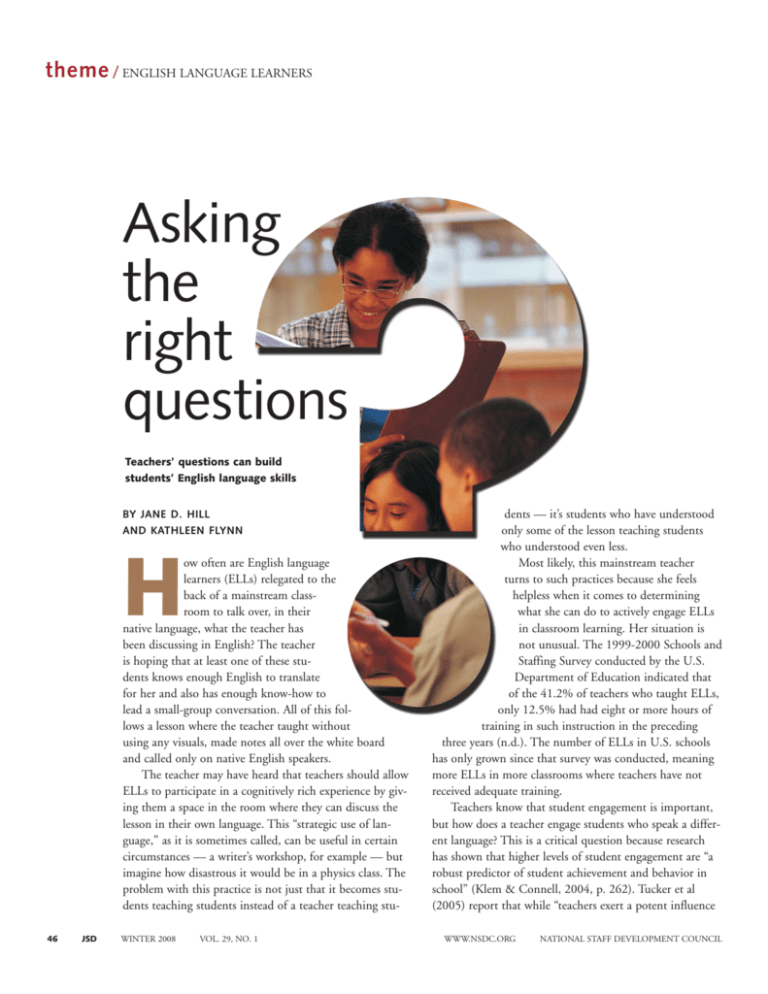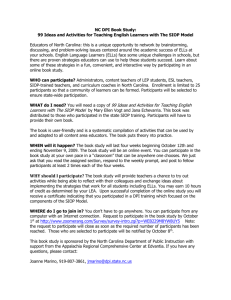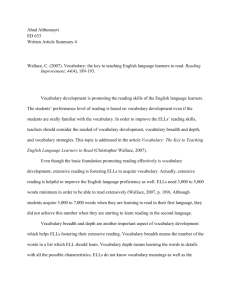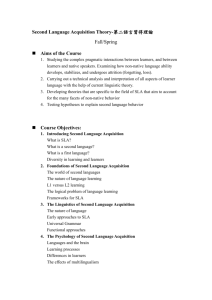"Asking The Right Questions" PDF
advertisement

theme / ENGLISH LANGUAGE LEARNERS Asking the right questions Teachers’ questions can build students’ English language skills BY JANE D. HILL AND KATHLEEN FLYNN ow often are English language learners (ELLs) relegated to the back of a mainstream classroom to talk over, in their native language, what the teacher has been discussing in English? The teacher is hoping that at least one of these students knows enough English to translate for her and also has enough know-how to lead a small-group conversation. All of this follows a lesson where the teacher taught without using any visuals, made notes all over the white board and called only on native English speakers. The teacher may have heard that teachers should allow ELLs to participate in a cognitively rich experience by giving them a space in the room where they can discuss the lesson in their own language. This “strategic use of language,” as it is sometimes called, can be useful in certain circumstances — a writer’s workshop, for example — but imagine how disastrous it would be in a physics class. The problem with this practice is not just that it becomes students teaching students instead of a teacher teaching stu- H 46 JSD WINTER 2008 VOL. 29, NO. 1 dents — it’s students who have understood only some of the lesson teaching students who understood even less. Most likely, this mainstream teacher turns to such practices because she feels helpless when it comes to determining what she can do to actively engage ELLs in classroom learning. Her situation is not unusual. The 1999-2000 Schools and Staffing Survey conducted by the U.S. Department of Education indicated that of the 41.2% of teachers who taught ELLs, only 12.5% had had eight or more hours of training in such instruction in the preceding three years (n.d.). The number of ELLs in U.S. schools has only grown since that survey was conducted, meaning more ELLs in more classrooms where teachers have not received adequate training. Teachers know that student engagement is important, but how does a teacher engage students who speak a different language? This is a critical question because research has shown that higher levels of student engagement are “a robust predictor of student achievement and behavior in school” (Klem & Connell, 2004, p. 262). Tucker et al (2005) report that while “teachers exert a potent influence WWW.NSDC.ORG NATIONAL STAFF DEVELOPMENT COUNCIL TIERED QUESTIONS In Classroom Instruction That Works With English Language Learners (Hill & Flynn, 2006), we recommend that teachers use questions frequently throughout a lesson because doing so Stages of second-language acquisition and tiered questions STAGE CHARACTERISTICS TEACHER PROMPTS Preproduction The student: • Has minimal comprehension. • Does not verbalize. • Nods “yes” and “no.” • Draws and points. • • • • Early production The student: • Has limited comprehension. • Produces one- or two-word responses. • Participates using key words and familiar phrases. • Uses present-tense verbs. • Yes/no questions. • Either/or questions. • Who, what, and how many questions. Speech emergence The student: • Has good comprehension. • Can produce simple sentences. • Makes grammar and pronunciation errors. • Frequently misunderstands jokes. • • • • Intermediate fluency The student: • Has excellent comprehension. • Makes few grammatical errors. • What would happen if …? • Why do you think …? • Questions requiring more than a onesentence response. Advanced fluency The student has a near-native level of speech. • Decide if … • Retell … Show me … Circle the … Where is …? Who has …? Why …? How …? Explain … Questions requiring a short sentence response. Source: Adapted from The Natural Approach: Language Acquisition in the Classroom, by Stephen D. Krashen and Tracy Terrell. Oxford, England: Pergamon, 1983. KATHLEEN FLYNN is a lead consultant at Mid-continent Research for Education and Learning (McREL). You can contact her at 4601 DTC Blvd., Suite 500, Denver, CO, 80237, 303-632-5563, fax 303-337-3005, e-mail: kflynn@mcrel.org. offers ELLs opportunities to use their new language and provides teachers with opportunities to assess ELLs’ understanding of the content being presented. However, teachers need to ask appropriate questions of English language learners. To use the strategy we recommend, which we call tiered questions, teachers must know the stages of language acquisition and be able to determine what stage each ELL is in. The chart above summarizes the five stages of language acquisition — preproduction, early produc- NATIONAL STAFF DEVELOPMENT COUNCIL 800-727-7288 JANE D. HILL is a lead consultant at Midcontinent Research for Education and Learning (McREL). You can contact her at 4601 DTC Blvd., Suite 500, Denver, CO, 80237, 303-632-5529, fax 303-337-3005, e-mail: jhill@mcrel.org. theme / ENGLISH LANGUAGE LEARNERS over the achievement of students,” they often have “lower expectations for and fewer interactions with minority students” (p. 29). These researchers tie students’ level of engagement to a teacher’s level of efficacy, e.g. a teacher’s belief that she can influence student performance. When faced with the task of educating students who don’t speak English, though, how many mainstream teachers believe that they can adequately instruct ELLs? In this article, we present an instructional strategy that helps teachers engage ELLs in learning, thus increasing their own belief that they can effectively teach English language learners, and we propose a professional development activity that will cement this strategy in teachers’ minds. The beauty of this strategy, which focuses on questions in the classroom, is that it helps teachers specifically address the needs of ELLs while also meeting the needs of every student in the classroom. It allows teachers to integrate learning for ELLs in mainstream classrooms and to help these students achieve academic success at the same levels as their native English-speaking peers. Finally, it shows teachers one direction for creating a supportive environment for English language learners. tion, speech emergence, intermediate fluency, and advanced fluency — as well as the characteristics of each, and appropriate prompts to use when questioning English language learners. By knowing the stages of language acquisition and stage-appropriate questions, a teacher can engage students at the correct level of discourse. Paying attention to teacher prompts that accompany the stages of acquisition is one way to help a student move to the next level of English proficiency. VOL. 29, NO. 1 WINTER 2008 JSD 47 theme / ENGLISH LANGUAGE LEARNERS Knowing the level of language acquisition also allows a teacher to work within the student’s “zone of proximal development” — that area between what the student is capable of at the moment and the point you want your student to reach next (Vygotsky, 1978). According to Vygotsky, you can work in a student’s zone of proximal development by “scaffolding” language development, or providing the support a student needs as she progresses. Scaffolding is essentially a way to nudge a student toward a higher level of performance. With language development, this can be done by modeling correct grammar or pronunciation, providing direct instruction, or asking While teachers challenging questions. use questions For example, if a student often, they tend is in the preproduction to ask lowerstage, he will be successlevel questions, ful at stage-appropriate e.g. questions tasks such as pointing, that ask finding, or circling a picstudents to ture. However, you can simply recall or scaffold further developrecognize ment by supporting him information, as he attempts tasks charrather than acteristic of the early prohigher-level duction stage, such as questions that answering yes/no quesrequire students tions or providing oneto analyze and word responses. In other evaluate words, if you adapt the knowledge. way you prompt, students will respond according to both their current stage and the stage just beyond. LOWER- AND HIGHER-LEVEL QUESTIONS Research has shown that cues and questions “are at the heart of classroom practice” (Marzano, Pickering, & Pollock, 2001, p. 113). In fact, cueing and questioning can account for as much as 80% of what occurs in a classroom on any given day (Marzano, Pickering, & Pollock, 48 JSD WINTER 2008 VOL. 29, NO. 1 Bloom’s taxonomy CONCEPT LANGUAGE FUNCTIONS Knowledge: Tell what you know or remember. • What is …? • Where is …? • Which one …? who, what, why, when, where, omit, choose, which, name, select, find, match, name, label, show, recall Comprehension: Demonstrate understanding of facts and ideas. • How would you compare …? Contrast …? • Which is the best answer …? • How would you classify the type of …? compare, contrast, demonstrate, illustrate, rephrase, show, classify Application: Use what you learn in another way. • How would you use ...? • What would result if …? • What other way would you plan to …? apply, build, choose, construct, develop, make use of, organize, plan, solve, model, identify Analysis: Look at something closely to find out more about it. • Why do you think …? • What inference can you make …? • What is the relationship between …? analyze, discover, dissect, infer, examine, survey, test for, relationships Synthesis: Put ideas or parts of things together. • What ways could...? • Why do you think …? • Imagine … build, combine, compile, create, design, formulate, imagine, invent, predict Evaluation: Tell if something is right or wrong, good or bad. • Do you agree/disagree …? • Why do you think …? • Decide if … criticize, decide, defend, evaluate, recommend, agree, appraise, opinion, disprove Source: Adapted from Taxonomy of Educational Objectives, by Benjamin S. Bloom. Boston: Allyn & Bacon, 1984. 2001). However, teachers are frequently unaware of how heavily they rely on cueing and questioning. In one study, elementary teachers who thought they were asking 12 to 20 questions each half hour actually asked 45 to 150 questions (Marzano, Pickering, & Pollock, 2001, citing Nash & Shiman, 1974). While teachers use questions often, they tend to ask lower-level questions, e.g. questions that ask stuWWW.NSDC.ORG dents to simply recall or recognize information, rather than higher-level questions that require students to analyze and evaluate knowledge (Marzano, Pickering, & Pollock, 2001). Research indicates that this occurs with all students, but the practice is particularly prevalent with English language learners (Ramirez, 1992) because teachers believe that these students cannot understand or respond to higher-level questions. NATIONAL STAFF DEVELOPMENT COUNCIL How, though, a teacher might ask, can I possibly ask a preproduction or early production student a question that involves analyzing information if the most the student can do is point or give a one- or two-word response? A teacher should not mistake ELLs’ limited level of output for their ability to think abstractly. It’s easy to keep asking preproduction students to show something by pointing, but the pointing can and must do more than have them recall knowledge. It’s easy to ask an early production student a question that requires a yes-no response, but the yes-no question doesn’t have to and should not center only on recalling knowledge. The chart on p. 50 uses a 3rdgrade classroom lesson on types of ani- NATIONAL STAFF DEVELOPMENT COUNCIL 800-727-7288 theme / ENGLISH LANGUAGE LEARNERS This is not true, as we will demonstrate, but to successfully ask higherlevel questions of ELLs, teachers must be conscious not only of the stages of language acquisition, but also of the levels of questions that they can ask each day of all their students. What distinguishes lower-level from higher-level questions? Readers likely use or recall Bloom’s Taxonomy, which provides a structure for categorizing the level of abstraction of questions (Bloom, 1984). (See chart on p. 48.) It illustrates the levels in the Taxonomy, which starts with lowerlevel questions — recalling information, for example — and concludes with higher-level questions — comparing and discriminating between ideas, for example. mals to illustrate how a teacher can align the stages of language acquisition with the various levels from Bloom’s Taxonomy in order to ask ELLs higher-level questions. For example, a teacher can ask a preproduction student a knowledge-level question, such as “Where is the raccoon?” as well as asking this same student to categorize types of animals, as in an analysis-level question: “Show me an animal that can’t live in the forest.” Similarly, an early production student can be asked to categorize: “What are the parts of a fish that help it live in the water?” With these higher-level questions, a teacher is truly engaging English language learners. (See chart on p. 50.) Because teachers must attend to asking higher-level questions of all students, VOL. 29, NO. 1 WINTER 2008 JSD 49 theme / ENGLISH LANGUAGE LEARNERS Bloom’s taxonomy across stages of language acquisition LINKING THINKING, LANGUAGE FUNCTIONS, AND LANGUAGE ACQUISITION Levels of thinking and language functions Language use across stages of second-language acquisition Moves from simple to complex in grammatical tenses, forms, vocabulary, etc. Level of thinking and academic language move from concrete recall to more complex and more abstract in any undertaking. Preproduction: Nonverbal response. Early production: One-word response. Speech emergence: Phrases or short sentences. Intermediate fluency: Longer and more complex sentences. Advanced fluency: Near native-like. EVALUATION Appraise, argue, assess, attach, choose, compare, defend, estimate, judge, predict, rate, select, support, value, evaluate Teacher mismatches animal with its environment and asks: Is this the right environment? Find the right environment. What are the best materials for the duck to build a nest? What makes a good home for a bear? (Examine settings and evaluate: “A cave makes a good home.”) What would happen if you put a worm in the desert? Recommend a different environment for a mother duck to raise her ducklings. Defend your choice. SYNTHESIS Arrange, assemble, collect, compose, construct, create, design, develop, formulate, manage, organize, plan, prepare, propose, set up Point to the animals that live in the soil. Say the names of the animals that live in the soil. How could you change a scorpion so it could swim? What would a clam need to survive in the desert? How would you protect the wildlife in a forest where hiking was very popular? ANALYSIS Analyze, appraise, calculate, categorize, compare, contrast, criticize, differentiate, discriminate, distinguish, examine, experiment, question, test Show me an animal that cannot live in the forest. Name the parts of a fish that help it live in the water. How are raccoons and squirrels the same? How are they different? How does a bear use its claws to catch fish? Gather berries? Why do you think a bear hibernates in winter? APPLICATION Apply, choose, demonstrate, dramatize, employ, illustrate, interpret, operate, practice, schedule, sketch, solve, use Show me what would happen if we put the fish in the desert. Tell me what would happen if we put a fish in the desert. How could you change the body of a fish to make it fly? How would you capture and transport scorpions to a zoo? How would a deer camouflage itself in the forest in winter? In the desert? COMPREHENSION Classify, describe, discuss, explain, express, identify, indicate, locate, recognize, report, restate, review, select, translate Show me where a deer lives. Tell me which animals eat meat. Why is a toad the color it is? Explain how a snake catches its prey. Why do fish need gills to live in the water? How do gills work? KNOWLEDGE Arrange, order, define, duplicate, label, list, name, recognize, relate, recall, repeat, reproduce Where is the raccoon? What is the name of this animal? What are the body parts of a turtle? Give the definition of a mammal. Tell me everything you know about a clam. Source: Adapted from Bloom’s Taxonomy, Halliday’s Language Functions, and Krashen’s Stages of Language Acquisition. Contributors: Mike Gaddis and Cynthia Bjork. 50 JSD WINTER 2008 VOL. 29, NO. 1 WWW.NSDC.ORG NATIONAL STAFF DEVELOPMENT COUNCIL ACTION RESEARCH To help teachers improve their questioning skills, we recommend an opportunity for professional development via action research. Action research allows teachers to “reflect on their practices and student results by studying teaching and learning” (Loucks-Horsley, Love, Stiles, Mundry, & Hewson, 2003, p. 162). In action research, a teacher forms her own research questions. In this case, the teacher is asking two questions: (1) Are my questions aligned with my students’ stages of language acquisition?; and (2) Am I asking higher-level questions of all my students? With these questions in mind, a teacher invites a colleague with whom he feels comfortable to come in for a class period and write down every question he asks — what the question was and which student was questioned. The teacher then reviews the transcript and analyzes his questions: 1. What questions did he ask of native English speakers? a. Chart where each question falls according to Bloom’s Taxonomy. (See the blank chart in the online version of this article at www.nsdc.org/jsd/.) 2. Did he ask questions of the English language learners? a. If not, why not? How can he learn to engage English language learners in the classroom experience? b. If yes, how closely did each question align to the ELL’s current stage of language acquisition or to one level beyond that stage? c. Chart where each question falls according to Bloom’s Taxonomy. Assume that the teacher finds some room for improvement when he analyzes his questions, as most teachers will. For the next six weeks, he NATIONAL STAFF DEVELOPMENT COUNCIL concentrates on developing and asking questions that are appropriate to each ELL’s stage of acquisition (or to one level beyond the student’s current stage), as well as on asking higherlevel questions of all students, both native English speakers and ELLs. Focusing solely on this one new practice for an extended period of time should make it easier for a teacher to achieve results. Six weeks later, the colleague comes in again to script the teacher’s questions. Will the teacher be perfect after six weeks? Of course not, but he should see marked improvement. And the improvement will not only be visible in that transcript of questions, he will also see an increased level of engagement in learning with all his students, and he will feel far less helpless in instructing ELL students. WHAT’S NEXT? Once a teacher is skilled at asking tiered questions, she should begin working toward giving students tiered assignments during class and tiered homework. The chart on p. 50, which aligns the stages of language acquisition with Bloom’s levels of abstraction, is as useful in forming assignments as it is in developing questions. Teachers should talk with each other about their tiered assignments and tiered homework to realize what works and what doesn’t. Samples of tiered assignments and tiered homework can be kept in a portfolio for next year’s teachers. And once a teacher masters tiered assignments and homework, it’s on to tiered assessments. CONCLUSION In Classroom Instruction That Works With English Language Learners, we note that language learning is not something that will “just happen” when English language learners are exposed to English in a mainstream classroom. Instead, teachers need to 800-727-7288 theme / ENGLISH LANGUAGE LEARNERS the last column in this chart provides questions a teacher can ask of both advanced fluency students and native English speakers. make language learning purposeful, intentional, and explicit. A teacher is being intentional when she pays careful attention to her questions. Questions that are not only aligned to a student’s stage of language acquisition but also focus on higher-order skills will allow ELLs to more fully engage in learning both language and content. Will it take additional time to prepare to engage all students in classroom activities? Yes, especially at first. But the payoff is huge — days of rich learning experiences for English language learners where a teacher, who previously felt helpless, is now confident that she has allowed her students to experience success in the classroom. REFERENCES Bloom, B. (1984). Taxonomy of educational objectives. Boston: Allyn & Bacon. Halliday, M.A.K. (1973). Explorations in the functions of language. London: Edward Arnold. Once a teacher Hill, J.D. & Flynn, is skilled at K.M. (2006). Classroom asking tiered instruction that works questions, she with English language should begin learners. Alexandria, VA: working toward ASCD. giving students Klem, A.M. & tiered Connell, J.P. (2004). assignments Relationships matter: during class and Linking teacher support tiered to student engagement homework. and achievement. Journal of School Health, 74(7), 262-273. Krashen, S.D. & Terrell, T. (1983). The natural approach: Language acquisition in the classroom. Oxford, England: Pergamon. Loucks-Horsley, S., Love, N., Stiles, K.E., Mundry, S., & Hewson, P.W. (2003). Designing professional development for teachers of science and mathematics (2nd ed.). Thousand Oaks, CA: Corwin Press. VOL. 29, NO. 1 WINTER 2008 JSD 51 theme / ELLs 52 Marzano, R.J., Pickering, D.J., & Pollock, J.E. (2001). Classroom instruction that works: Research-based strategies for increasing student achievement. Alexandria, VA: ASCD. Nash, R.J. & Shiman, D.A. (1974). The English teacher as questioner. English Journal, 63, 42-45. Ramirez, J.D. (1992). Executive summary of the final report: JSD WINTER 2008 VOL. 29, NO. 1 Longitudinal study of structured English immersion strategy, early-exit and late-exit transitional bilingual education programs for language minority children. Bilingual Research Journal, 16, 1-62. Tucker, C.M., Porter, T., Reinke, W.M., Herman, K.C., Ivery, P.D., Mack, C.E., & Jackson, E.S. (2005). Promoting teacher efficacy for working with culturally diverse students. Preventing School Failure, 50(1), 29-34. U.S. Department of Education, National Center for Education Statistics. (n.d.). Schools and staffing survey: 1999-2000. Available at nces.ed.gov/pubs2002/2002313.pdf. Vygotsky, L.S. (1978). Mind in society. Cambridge, MA: Harvard University Press. n WWW.NSDC.ORG NATIONAL STAFF DEVELOPMENT COUNCIL







